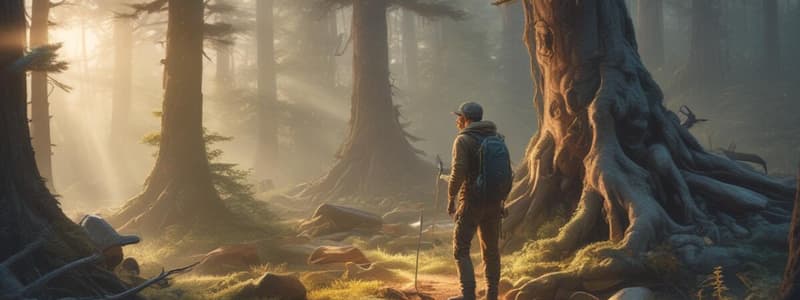Podcast
Questions and Answers
What is the typical capacity of a backpack for backpacking?
What is the typical capacity of a backpack for backpacking?
- 50-60L
- 30-40L (correct)
- 20-30L
- 40-50L
What is an essential skill for backpacking?
What is an essential skill for backpacking?
- Fishing
- Swimming
- Wilderness first aid (correct)
- Rock climbing
What type of campfire is used for boiling water or cooking small meals?
What type of campfire is used for boiling water or cooking small meals?
- Log Cabin
- Bonfire
- Tepee (correct)
- Reflective Fire
What is a cooking method used in campfire cooking?
What is a cooking method used in campfire cooking?
What is an essential item for campfire cooking?
What is an essential item for campfire cooking?
Why should you keep a bucket of water nearby when cooking over a campfire?
Why should you keep a bucket of water nearby when cooking over a campfire?
What should you consider when planning a backpacking itinerary?
What should you consider when planning a backpacking itinerary?
What is a benefit of choosing multi-use gear for backpacking?
What is a benefit of choosing multi-use gear for backpacking?
Flashcards are hidden until you start studying
Study Notes
Backpacking
- Definition: A form of camping where hikers carry all their gear on their backs, typically on multi-day trips into remote areas.
- Essential Gear:
- Backpack (30-40L capacity)
- Sleeping bag and pad
- Tent
- Clothing and footwear
- Headlamp and first aid kit
- Water bottle or hydration bladder
- Food and cooking gear
- Key Skills:
- Navigation (map, compass, GPS)
- Shelter setup and takedown
- Water purification and treatment
- Food preparation and storage
- Wilderness first aid
- Tips:
- Pack lightly and efficiently
- Choose multi-use gear to reduce weight and space
- Plan itinerary according to weather and terrain
- Bring a repair kit with duct tape, safety pins, and cord
Campfire Cooking
- Types of Campfires:
- Tepee: Small, compact fire for boiling water or cooking small meals
- Log Cabin: Larger fire for cooking larger meals or groups
- Reflective Fire: Fire built against a rock or log to reflect heat
- Cooking Methods:
- Grilling: Direct heat cooking over flames or coals
- Boiling: Cooking in a pot of boiling water
- Steaming: Cooking in a steamer basket over boiling water
- Dutch Oven: Cooking in a heavy pot with a tight-fitting lid
- Campfire Cooking Essentials:
- Cooking Pot: Lightweight, durable pot with lid
- Utensils: Spatula, fork, knife, and tongs
- Fuel: Fire starter, kindling, and larger logs
- Food Storage: Airtight containers and coolers
- Safety Tips:
- Keep a bucket of water nearby to extinguish the fire
- Monitor wind direction to avoid sparks and smoke
- Keep children and pets at a safe distance
- Follow local campfire regulations and permits
Backpacking
- Backpacking is a form of camping where hikers carry all their gear on their backs, typically on multi-day trips into remote areas.
- Essential gear for backpacking includes a backpack with 30-40L capacity, sleeping bag and pad, tent, clothing and footwear, headlamp, first aid kit, water bottle or hydration bladder, and food and cooking gear.
- Key skills required for backpacking are navigation using map, compass, and GPS, shelter setup and takedown, water purification and treatment, food preparation and storage, and wilderness first aid.
- Important tips for backpacking include packing lightly and efficiently, choosing multi-use gear, planning the itinerary according to weather and terrain, and bringing a repair kit.
Campfire Cooking
Types of Campfires
- Tepee campfires are small, compact fires for boiling water or cooking small meals.
- Log Cabin campfires are larger fires for cooking larger meals or groups.
- Reflective campfires are built against a rock or log to reflect heat.
Cooking Methods
- Grilling involves direct heat cooking over flames or coals.
- Boiling involves cooking in a pot of boiling water.
- Steaming involves cooking in a steamer basket over boiling water.
- Dutch Oven cooking involves cooking in a heavy pot with a tight-fitting lid.
Campfire Cooking Essentials
- A cooking pot is a must-have for campfire cooking, and it should be lightweight and durable with a lid.
- Essential utensils for campfire cooking include a spatula, fork, knife, and tongs.
- Fuel for campfire cooking includes a fire starter, kindling, and larger logs.
- Food storage is crucial for campfire cooking, and airtight containers and coolers are necessary.
Safety Tips
- It's essential to keep a bucket of water nearby to extinguish the campfire.
- Monitor wind direction to avoid sparks and smoke when cooking over a campfire.
- Keep children and pets at a safe distance from the campfire.
- Follow local campfire regulations and permits to ensure safe and responsible campfire cooking.
Studying That Suits You
Use AI to generate personalized quizzes and flashcards to suit your learning preferences.




